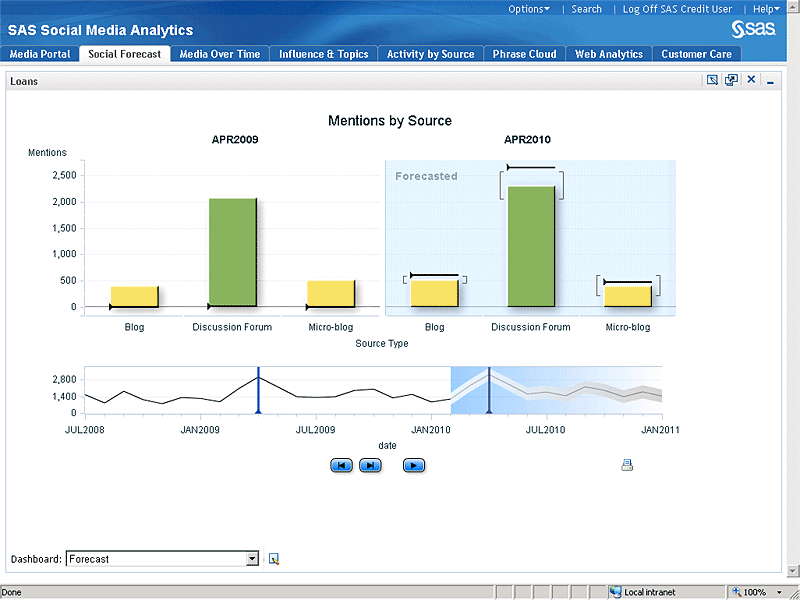 How are you measuring your social media efforts? Whether you're just getting started or have spent years fine tuning your goals and measurments for social media, you'll learn something below from industry pros Katie Paine, CEO KDPaine & Partners, and Mark Chaves, Director of Media Intelligence, Customer Intelligence Product Marketing at SAS:
How are you measuring your social media efforts? Whether you're just getting started or have spent years fine tuning your goals and measurments for social media, you'll learn something below from industry pros Katie Paine, CEO KDPaine & Partners, and Mark Chaves, Director of Media Intelligence, Customer Intelligence Product Marketing at SAS:
- Think of measurement as a guidance system, not a rating system“Measurement shouldn’t be about punishment or rewards,” said Katie. “It is about figuring out what the most effective tools are, what needs to be discontinued because it doesn’t work, and what needs to be done more because it does work.
- Track the elusive sentimentText analytic tools can categorize online content, uncover linked concepts, and reveal the sentiment in a conversation as “positive,” “negative” or “neutral,” based on the words people use. The technology gets down to very specific elements and can separate positive and negative remarks within a single comment. “A mixed-polarity phrase, such as ‘hotel in great location but bathroom was smelly’ should not be tagged as ‘neutral,’ if you want it to be actionable,” said Mark. “Be specific; ‘bathroom was smelly’ is something someone can own and improve upon.”
- Continuously improve the accuracy of text analysisAn industry-specific text analytics package will already know the vocabulary of your business. The system will have linguistic rules built into it, but it learns over time and gets better and better. Much as you would tune a statistical model as you get more data, better parameters or new techniques to deliver better results, you would do the same thing with the natural language processing that goes into sentiment analysis. You set up rules, taxonomies, categorization, meanings of words; watch what the results look like, and then go back and do it again.
- Look at the ripple effectIt’s one thing to get a great hit on a high-profile site, but that’s only the start. There’s a difference between a great hit that just sits there and goes away, versus a great hit that is tweeted, retweeted and picked up by influential bloggers. Analysis should show you which social media activities go “viral” and which quickly go dormant – and why.
- Look beyond the brandThe biggest mistake people make is to concern themselves only with looking up their brand, said Katie. “That’s the last thing you want to do.” To successfully analyze and act on social media, you need to understand not just what is being said about your brand, but the broader conversation about the spectrum of issues surrounding your product or service.
- Identify your most powerful influencersYour most important influencers are not necessarily the ones who advocate specifically for your brand; they are the ones who influence the whole realm of conversation about your topic, said Mark. “Are they saying nice things, expressing support or simply making observations or critiquing? What is the nature of their conversations? How is my brand being positioned relative to the competition in that space? Once you have that big, broad picture, then you can build your strategy.”
- Look closely at the accuracy of your analytic toolUntil recently, computer-based tools were not as accurate as humans for sifting through online content, said Katie. “If you train readers well and give them very specific coding instructions, you can get two readers to agree 88 percent of the time, on average. The [automated]system I initially used and then discarded was 45 percent accurate. The best I’d ever had, prior to using SAS, was 65 percent accuracy. So when SAS Social Media Analytics gets up to 90 percent accuracy, I say, ‘Okay, I believe it; computers can actually do this.’”
- Incorporate social media intelligence into planningA first step is to find time-linked associations between social media metrics and other business activities or market events. “Social media is typically either organically invoked or invoked by something your organization does,” said Mark. “If we saw a spike in activity in April, we want to know, what was behind that?”
Continue reading "8 practical tips for social media measurement"

1 Comment
Accuracy is one essential element, and while automated sentiment analysis is a big buzz word now, we cannot neglect the human element. Emotion is human likewise interpretation of emotion requires humans as well, which is why we do not remove humans from the equation. Computers are a brilliant thing but we have yet to find anything that can surpass the human mind. Situations change, our use of words, and language can change, so we cant leave sentiment solely on computers just yet.